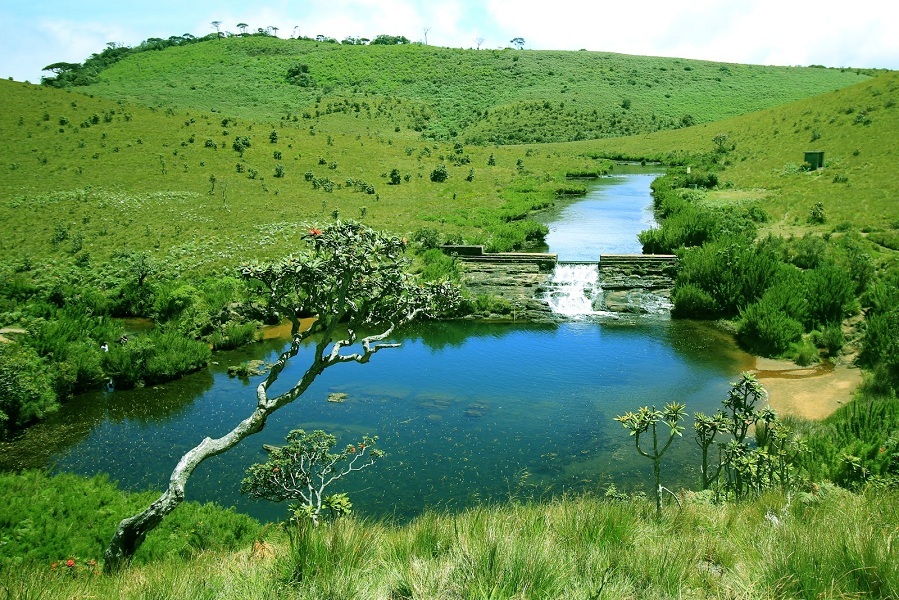Horton Plains – breathtaking highland plateau in the Central Hills-By Arundathie Abeysinghe

Image Source : trawell

Situated at 2535 meters, surrounded by breathtaking mountains and grassland, Horton Plains is a spectacular highland plateau which includes World’s End, the fabled viewpoint, a precipice with a 1050 meter drop with the highland reaching an abrupt end with dramatic and breathtaking views rendering a cinematic experience. The most popular sight at Horton Plains is the World’s End. There is a viewing deck at World’s End.
There is also a Mini World’s End on the trail to World’s End. For a visitor traveling from Central Highlands to the south coast, the road through Horton Plains National Park is a magnificent route with variations of climate and stark contrasts of vegetation.
Situated at the southern end of the Central Highlands about 32 kilometers from Nuwara Eliya and traditionally known as “Mahaeliya” (Great Open Plain) in Sinhala, British Tea Planter Thomas Farr rediscovered this plateau in the 19th century and renamed it after Sir Robert Wilmot Horton, Governor of Ceylon (present Sri Lanka) from 1831-1837.
Spread over 3,159.8 hectares, Horton Plains is home to a rich and unique biodiversity covered by montane grassland and cloud forest. The Plains covers 3160 hectares of grasslands interspersed with forest and undulating plateau of almost 2000 meters in height, a breathtaking and an outstanding terrain, a contrast to the environment in the Central Highlands as well as an atmosphere extraordinarily different from other regions in Sri Lanka.
To the West of Horton Plains lies Kirigalpoththa, Sri Lanka’s second highest mountain (2,393 meters) and to the North is Sri Lanka’s third highest mountain, Totupola Kanda (2,359 meters) which can be seen from the Plateau. Besides these high peaks, Horton Plains cradles the Belihul Oya (Oya meaning stream in Sinhala), Bogawanthalawa Oya and Agra Oya, the source streams from which Sri Lanka’s major rivers Mahaweli, Kelani and Walawe originate.
Horton Plains was gazetted as a Nature Reserve in 1969 and has since been named as the first ever eco-friendly National Park in Sri Lanka in 1988, because of its unique watershed and biodiversity value; its windswept, misty grassland comprising tree ferns and scraggy dwarf trees (some endemic to Sri Lanka). Interspersed by icy-cold rivulets, Horton Plains is a spectacular location in Sri Lanka.
Among the trees and plants unique to Horton Plains, the most striking are Binara, Dwarf Bamboo, Patana grass and the tree fern Maha Meemana which dot the forest openings.
On a clear morning, to the South of Horton Plains, the Indian Ocean is visible similar to a fabulous silver crescent. Dawn is the ideal time to see this sight as the mountains are free of mist at that time.
November to February is the coolest period, at times with heavy ground frost at night. During the rest of the year there is rainy weather, brought both by Northeast and Southwest monsoons and inter-monsoons. Horton Plains consists of grasslands interspersed with areas of forest and some unusual vegetation that grows only in high altitudes. There are 52 species of endemic birds and 11 species of migrants which visit the Park from November to March every year.
Among the endemic birds, Yellow Eared Bulbul (Pycnonotus penillatus), Sri Lanka White Eye (Zosterops Ceylonesis), Whistling Thrush (Myiophonus bligi), Dull Blue Flycatcher (Eumiyas Sordida) and the Mountain Hawk Eagle (Spazaetus Nupalensis) can be seen in large numbers.
Majestic Sambar is a common sight at Horton Plains and roams freely in the grassland. At times, large herds of Sambars can be seen in the Plains. Leopard is a rare sight at Horton Plains. But the big cat panther (Panthera Padus Kotiya) can be sighted at dawn. Bear Monkeys (Trachypithecus Vetulus Monticola), Giant Squirrels, Barking Deer, Fishing Cats and wild boar can be spotted at dawn. Hence, Horton Plains is a haven of wild life.
According to records, before 1930s, there had been elephants in the Plains.
Horton Plains can be explored from early morning (no vehicles are allowed to enter the Park). During the return journey from World’s End, scenic Baker’s Falls and Galagama Falls can be seen. Baker’s Falls is a spectacular sight and there is a track leading to the waterfall with well-constructed stairs.
The trek to World’s End is almost five kilometers along a flat path. The ideal time to visit the breathtaking exotic highlands is early in the morning as the mist engulfs the viewpoint at World’s End by mid afternoon obscuring the view.
According to foreign tourists, Horton Plains resembles the African savannah.
Horton Plains is the only National Park in Sri Lanka where visitors are allowed to walk on their own on designated tracks.








One Comment